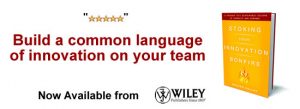Innovation for the Non-Profit Sector
 Non-profit organizations need innovation every bit as much as for-profit firms. Some might argue they need it more because they lack the resources and cash flow of large commercial firms. Non-profits need innovation in:
Non-profit organizations need innovation every bit as much as for-profit firms. Some might argue they need it more because they lack the resources and cash flow of large commercial firms. Non-profits need innovation in:
- Fund Raising
- Expanding their reach
- Mission delivery
- Resource utilization
The need for innovation in the non-profit sector is widely recognized. Awards, grants, and other forms of recognition for innovative programs help stimulate managers to be more aggressive.
While the need is recognized, the approach to innovating non-profits is not. These organizations should use the same methods found so effective in corporate innovation. Structured methods based on patterns inherent in inventive solutions can be applied to the non-profit business model just as effectively as the for-profit model. A method like S.I.T. can help an organization “break fixedness” about its role, resources, and process, thus opening new possibilities and approaches.
Here is how I would do it. Start by making a list of the components of the non-profit, both internal to the firm as well as external. The list might include:
- Office
- Volunteers
- Phones
- Fund Raising Events
- Web site
- Promotional Material
- Donations and Grants
- Beneficiaries
- Benefactors
- Mission Statement
- Management Board
- Executive Director
Start with a tool like Subtraction. Try removing an essential internal component (for example, donations and grants). Use “Function Follows Form” to imagine benefits and uses of all the remaining components. Try it with other components. Next, use the Task Unification tool. This tool helps you see existing resources in a new light, usually creating innovative ways to use those resources. Finish the exercise with one of the three remaining tools. Division, for example, will likely create new configurations of the non-profit and stimulate innovative ideas. For example, try dividing out some of the executive director’s roles but placing them somewhere else back in the “Closed World.” Where would those roles go and why would that be beneficial?
Here are some creative examples from the non-profit sector (courtesy of PSFK):
- Nonprofit Shopping Mall is a new service that turns consumer dollars into charitable donations. The organization partners with major online retailers like Target, Amazon, Home Depot, Bloomingdales, Expedia, Petco, and iTunes. They donate a percentage of each purchase to the nonprofit of choice. A shopper begins on Nonprofit Shopping Mall, choosing a charity and clicking through to a retailer. Tracking data is used to identify which shoppers came via Nonprofit Shopping Mall, and which charities they’ve chosen to donate to.
- Holiday Matinee recently worked with a local, non-profit charter school-offering its students an opportunity to design their own silkscreen tees, which they then voted on which designs to take part in their Artist Series. 100% of all the proceeds from these shirts go to school funding.
- Can Too is an Australian non-profit program that provides professional training in running and swimming in exchange for charitable fund raising. Members are given twice-weekly training sessions, daily guides, speakers and social events. In return, they have to raise funds for Cure Cancer Australia. Runners can train for 10K or half marathon and full marathon events while swimmers can choose from among 1 km, 2 km and 2.7 km ocean swims and raise funds when they participate in their respective events. Can Too has raised more than AUD 4 million for Cure Cancer Australia.
- The MarkProf Foundation is a non-profit organization in Manila. Its main event is an all-expenses paid, seven week “boot camp†led by multinational CEOs and reputable captains of local industry. Participants from diverse socio-economic backgrounds are ranked based on two core virtues: innovation and inquisitiveness. The proof of success is in quality job creation. “MarkProf is already the biggest source of management trainees for some of the top multinational companies in the Philippines†says current president, Jem Perez who also refers to the organization as a “resume equalizerâ€.
Editor’s Note: Be sure and also check out our FREE white paper on Charitable Innovation

Don’t miss an article (2,200+) – Subscribe to our RSS feed and join our Innovation Excellence group!
 Drew Boyd is Assistant Professor of Marketing and Innovation at the University of Cincinnati and Executive Director of the MS-Marketing program. Follow him at www.innovationinpractice.com and at https://twitter.com/drewboyd
Drew Boyd is Assistant Professor of Marketing and Innovation at the University of Cincinnati and Executive Director of the MS-Marketing program. Follow him at www.innovationinpractice.com and at https://twitter.com/drewboyd
NEVER MISS ANOTHER NEWSLETTER!
LATEST BLOGS
Starbucks and Big Tobacco
Back in the 1950’s smoking was glamorous, and just about everybody who was anybody smoked cigarettes. Then came the discovery, to the shock of millions, that sucking smoke into your lungs might not be good for you. Then came another revelation that one of the substances in tobacco, nicotine, which was used as a poison by the Egyptians during the times of the Great Pyramids, is addictive. People then began a mass exodus from the consumption of nicotine via inhaled smoke.
Read MoreWal-Mart Goes Green – What about your company?
With the price of gas above $3.00, some companies (and hopefully all) are beginning to look at the fuel efficiency of their fleets. Wal-Mart is the most public example of this with its trucking fleet. Its efforts include:
Read More



We are a non-profit organization providing jobs to rebuild lives . We strive to put service above self . We volunteer within the community that include landscaping , trash removal , and feeding the homeless .